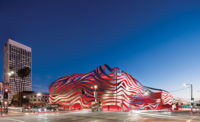Lighting Design Pioneer Jules Horton Dies at 87
 Image Courtesy Horton Lees Brogden |
Jules Horton, a member of an exclusive circle of designers who established architectural lighting as a profession, died at his home in New York this winter at the age of 87. A series of small strokes had confined him to a wheelchair since 2001. Although he passed away on February 23, his death was made public last week.
After earning degrees in structural engineering from Warsaw Polytechnic Institute and Columbia University, Horton opened Jules G. Horton Lighting Design in 1968, applying an auto-didactic nature to an embryonic field. For the Dallas/Fort Worth International Airport, opened in 1969, he overcame the then-under-recognized phenomenon of glare by lining roadways with fixtures that spread light away from the eyes of drivers. Inside the terminal, he alternated colored lighting to create a wayfinding system for travelers.
Barbara Cianci Horton, a senior principal of the firm now called Horton Lees Brogden Lighting Design, says Horton had a particular knack for “looking at other industries to apply to his newfound industry.” To this end, he would routinely study equipment taken for granted by the professionals for whom it was originally manufactured—such as U-shaped T12s used in signage—and then re-imagine the fixture in innovative installations or unexpected locations. Projects such as the decorative lighting “necklaces” of New York’s Triborough and Whitestone bridges helped to legitimize the practice of architectural lighting.
Horton’s inquisitiveness, which not only characterized his design career, helped him survive a nightmarish past. As a Polish teenager during World War II, he was sent to a Russian labor camp in Arkhangelsk Islands, just south of Siberia. There, working as a lumberjack, he learned the native language and became a liaison between Russian authorities and Polish prisoners. His usefulness meant that he was able to receive surgery after a serious accident—and ultimately enabled his release from the camp.
Although Horton officially retired from work 15 years ago, his innovative sensibilities continue to pervade the firm, which now counts 43 employees. He will be honored posthumously at the International Association of Lighting Designers Awards Dinner, in May, and at the Lumen Awards the following month.




